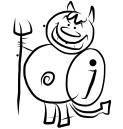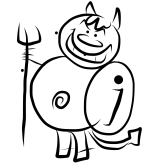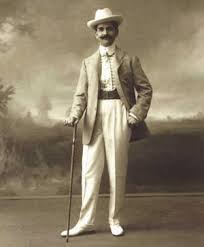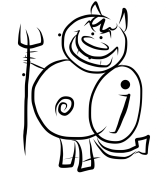It is a truism that while an Imp’s work may make little impression in their own time, the more impish the oeuvre the bigger the impact after their death and the poster boy for this axiom is Alfred Jarry Grand ‘Pataphysician. Marcel Page takes a little gander at his life and influence.
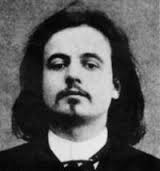
Despite selling somewhere between nothing and bog all during his own lifetime Alfred Jarry’s work and ideas have fired up successive generations of artists and theorists. It can be argued that he is (directly and indirectly) one of the greatest influences on 20th and 21st century art and thought. Not bad for a drunk who died a pauper of bicycle related meningitis at the age of 34.
A monstrous intellect Jarry was famous in his own time for unleashing the play Ubu Roi on the unsuspecting French public. The play caused a riot in the theatre, simply for being about seventy years too early. However, as wonderful a display of Impishness Ubu Roi is (more of which below) it is his science of ‘Pataphysics which Jarry is now most known for. A science (or philosophy, or neither of these) which evades easy explanation but has influenced the work of Duchamp, the surrealists, Artuad, Soft Machine, Gong and Foucault – not to mention too many more to mention.
Laval forms
Jarry was born in 1873 in Laval just outside of Brittany in France. His father was a middle class petit-bourgeois alcoholic who apparently took very little part in Jarry’s upbringing. His mother was of faded Brittany ancestry and was regarded as the town’s resident eccentric. After she split from her husband she took her children (Jarry had a sister Charlotte)to live in Brittany for a while, a place, with its ancient Celtic pace of life and old customs, which was to have a lasting effect on Jarry’s imagination. He also received his first bicycle.
At the age of fifteen Jarry, who had grown into a short thickset boy (he never grew to more than five foot odd in his life) was studying in the Lycée in Rennes. It was here that he was to meet the man who was to transform his life. The stories of many great artists are transformed in the crucible the great teacher, and this was no different in Jarry’s case – only in the ‘Pataphysical crucible transforming teacher was useless.
Poor Monsieur
Monsieur Hébert was the physics teacher at the Lycée, whose lessons were infamous for the sheer brutality inflicted on poor Monsieur Hébert by the boys. By the time that Jarry joined the school the boys had worked out a whole mythology for Monsieur Hébert – or Pere Héb as he was known. From being a terrible teacher Pere Héb had become the fat offspring of a Ginormant and a Mongolian witch, complete with extendable ear. Jarry and his friends the Morin brothers took this oral mythology and ran with it, writing and performing a series of marionette plays based on Pere Héb.
Poor Hébert, a provincial school teacher with a miserable working life could never imagine that he would be the inspiration for one of the most shockingly modern plays ever made. Likewise the generations of his evil minded tormentors could never imagine that their merciless bullying could give shape to and form to a character without whom the modern imaginative life would be a greyer, safer place. Pere Héb eventually became Pere Ubu, that great fart in the face of respectability.
Paris
That lay slightly in the future, as for Jarry Paris beckoned. Unlike most people Jarry could not leave his school boy enthusiasms behind and took them with him when he left for Paris. Jarry hit Paris with a bang, and soon found himself swept up in the world of literary salons, especially that which surrounded the literary publication Le Mercuré, and café society. His outrageous dress , long cape and stove pipe hat apparently, and behaviour would have soon had him noticed anyway. Moments from the legend of Jarry in this period include:
Inviting his friends around to the darkened owl filled apartment he lived in, frightening them so much that they fled opening the door by its shit covered handle.
Turning up to an opening night bare-chested with a shirt painted on.
Habitually firing revolvers in the air.
Living in an apartment that was cut horizontally in half, and was so small that even Jarry’s head brushed against the ceiling.
developing a highly idiosyncratic, a stress free staccato, automaton way of speaking.
Using the royal we to describe his own personage.
Drinking gallons of Absinthe.
Painting his face green.
Trying to shoot a fellow poet.
Attempting to light a stranger’s cigarette through the judicious use of a revolver.
Dressed habitually in cycling wear and riding everywhere – forty miles each way on the occasions he was living in a tripod suspended shack outside of Paris.
It was in Paris that Jarry was to write the bulk of his work and create – or at least refine ‘Pataphysics. Originally influenced by the symbolists and their anti-realist anti-naturist ideology of describing not the object – or thing – but the effect of the object or thing, Jarry’s work began include his own scatological humour, anti-clericalism and interest in the cutting edge science of the age.
Jarry’s work from this period becomes less Symbolic and more idiosyncratically ‘Pataphysical. His first two published books Les Minutes de sable mémorial (Black Minutes of Memorial Sand) and the unperformable semi-heraldic play César-Antichrist are both highly symbolic and personal. The play Haldernablou in Les Minutes… refers to the end of his love affair with the poet Léon-Paul Fargue They do however, point towards ‘Pataphysics with Ubu making an appearance in both tying the earthly with the heavenly. However, unlike most of symbolism Jarry’s use of imagery was deliberately crude and rough.
By 1896 Jarry is a fixture on the Parisian literary scene – both his parents have died and had left him with a reasonable inheritance which he quickly spent on funding an expensive magazine dedicated to the dying art of woodcuts called L’Ymagier. It bombed.
He had also been called up to the army, a situation he was completely unsuited for, being too short for the uniform causing his fellow recruits to fall into fits of laughter every time he went on parade. He also followed army rules to the letter, which pushed them to their illogical extremes. After feigning illness – according to Alastair Brotchie, by swallowing picric acid to induce the symptoms of gallstones Jarry was discharged and returned to Paris.
The experience in the army led directly into Jarry’s novel Les Jours et les Nuits (Days and Nights). The novel was the first real flowerings of ‘Pataphysics. In the novel Sengle is conscripted into the army and “escapes” through various dream states. This mingling of the real and the imagined, the perception of reality as a hallucination which is true, would be refined and redefined over Jarry’s lifetime to become the ‘science of imaginary solutions’. It was this science that has ensured Jarry’s lasting influence. However, by the time Les Jours et les Nuits was published Jarry had become famous. Ubu had hit the stage.
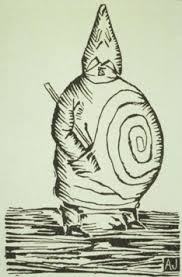
Ubu riot
The opening night of Ubu Roi has been described so many times that there really is little more to write about it. What there is to be said is that in the bastion of supposedly Avant-Garde theatre Jarry unleashed a human puppet play, whose action and language owed as much to Elizabethan drama, and mime as it did to ideas of performance not yet in vogue. To paraphrase Alastair Brotchie in his excellent biography of Jarry : A Pataphysical Life, it was as if a pop art sixties absurdist play had landed in the middle of the 19th century theatre. It play caused much uproar and a few punch-ups between the audience. It had made Jarry a well-known name. It also caused the eccentric Jarry’s personality to be confused in the public’s mind – and to some extent, his own – with that of Ubu.
From that point on Jarry and Ubu would be inextricable. His other work ignored or misunderstood, Jarry increasingly driven into poverty would be required to play the marionette role. By the time of his death, not from over consumption of absinthe, but from tubercular meningitis brought on by his cycling in all sorts of foul weather, Jarry was largely a forgotten man. Yet while Ubu looms large over the landscape of modernist theatre it is his science of Pataphysics that has secured his lasting influence. (You finally got there you don’t half like to rabbit! Ed.)
‘Pataphysics
‘Pataphysics is the science of imaginary solutions. An idea that opposites do not just rely on each other to support their existence but are also one and the same, the properties of one being the properties of the other. Jarry demonstrated by the se of Ubu’s Phsick stick which rotates and thus encompasses both the + and the – sign. Put more technically it is the study of the epiphenomenon, or the accidental offspring of a phenomenon rather than the phenomenon itself. Or possibly the influence of the imaginary (artistic) will on reality and the conflation of the two to create a third.
Not being easily definable has meant that ‘Pataphysics has allowed each person who encounters it a great deal of personal freedom in their application of it. Jarry’s own key Pataphysical works are to be found in his speculative journalism like The Passion considered as an uphill Bicycle race, and How to Construct a Time Machine. Pieces where logic is turned on its head and pushed to illogical conclusions. In the first the stations of the cross are reimagined as a piece of sports journalism, and the in the latter the poetic description of bicycle ride is rendered as serious piece of scientific speculation – so well constructed was How to Construct a Time Machine that it was briefly taken seriously by some English scientists.
The longest exposition of ‘Pataphysics was Jarry’s own posthumously published Exploits and Opinions of Doctor Faustroll: Pataphysician. In which the titular Doctor Faustroll travels around Paris in a sieve alighting on various islands, which are infact descriptions of the Parisian literati as described by the liniments of their work. Eventually Faustroll dies and the book ends with the algebraic formula describing the surface of God. In the novel, art, science, humour and ways of seeing are all mixed together into one great melting pot.
Lasting influence
But it was not Jarry who brought ‘Pataphysics to the fore, it was the artists who followed him. Picasso and Duchamp have both acknowledged a debt to Jarry’s ideas. Duchamp’s Ready Mades are incredible ‘Pataphysical in their mixture of philopshy absurdity and generally taking the piss. Artaud’s Theatre of Cruelty was influenced by Ubu, which in turn influenced Jim Morrison’s stage presence. Both the Dadaist’s and The Surrealist were attracted by Jarry’s humour and anti-realism. Yet it was a group of break-away Surrealists who have carried Jarry’s influence on through the years. The College of Pataphysics, used Pataphysics as starting point for a whole creative life based on Pataphysical ideas. The OuLiPo writers, which included Georges Perec and Raymond Queneau, used scientific and mathematical constraints to create new pieces of literary work, and were formed out of the College of Pataphysics.
In the sixties through the merging of the older Avant-Garde and growing psychedelic movement Pataphysics could be felt. Paul McCartney, a partner in the Indica bookshop had heard a version of Jarry’s Goonish play Ubu Cuckolded on the BBC. Pataphysics was soon name checked in The Beatles Maxwell’s Silver Hammer.
Darlings of the UFO and later Jazz-Rock heavyweights Soft Machine were made the official orchestra of the College of ‘Pataphysics. Since then the Pataphysical mindset has grown, Martin Craig-Martin’s An Oak Tree is a wonderful example of ‘Pataphysics at work. Sixties pop art with its conflation of high and low art, also has ‘Pataphysical resonances – the pop art world wasn’t entirely unaware of Jarry, David Hockney designed the sets for a London run of Ubu Roi featuring Max Wall.
In America the comic strip Zippy the Pinhead has many ‘Pataphysical themes, as did George Melly and Wally Fawkes Flook which was printed in The Daily Mail from 1949 to 1984 contained many ‘Pataphysical elements.
Where art and ideas are taken to their illogical conclusion is where you find ‘Pataphysics. You can be ‘Pataphysical without knowing it, for me the drone metal work of Sunn 0))) and the work of Spike Milligan owe something to the ‘Pataphysical spirit. ‘Pataphysics is now everywhere – London even has its own branch the London Institute of ‘Pataphysics – and has been the study of many books and its influence on the modern landscape is undeniable. Not a bad legacy for an obscure bike rider from just outside Brittany.
For further information on Jarry and Pataphysics I would heartedly recommend Alastair Brotchie’s Alfred Jarry a Pataphysical Life (MIT Press 2011). I would also recommend Andrew Hughill’s ‘Pataphysics : A useless guide (MIT Press 2012). Atlas Press in London also print many of Jarry’s works and pieces related to the London Institute of ‘Pataphysics.
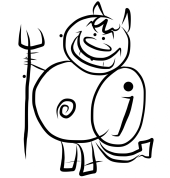
Marcel Page likes writing things like this. We like them too.
